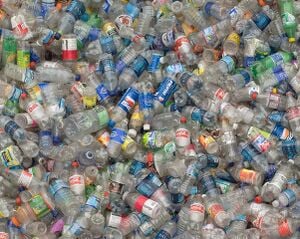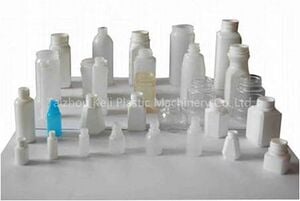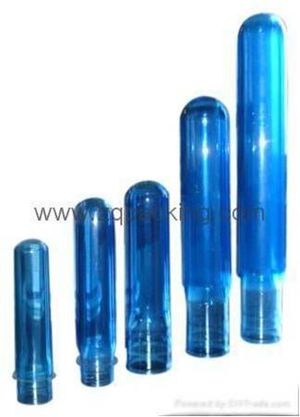No edit summary |
m (-vandalism) |
||
| Line 1: | Line 1: | ||
[[Image:Plastic-water-bottles.jpg|thumb]] | [[Image:Plastic-water-bottles.jpg|thumb]] | ||
== Recycling plastic bottles == | == Recycling plastic bottles == | ||
| Line 31: | Line 28: | ||
<br> | <br> | ||
== Health concerns == | == Health concerns == | ||
Revision as of 20:49, 18 May 2015

Recycling plastic bottles
Plastic bottles can be used in water treatment: a simple method of solar water disinfection involves leaving a PET bottle with water in the sun. (See the article for all the steps, and length of time needed for treatment.)
...and in building:
- Ecoladrillo
- See also this small one-off cottage: The House of Plastic Bottles, September 18th, 2009
...and in gardening:
Where does plastic come from?
Plastic Bottles Come From Virgin Sources.
- PET = Polyethylene Terephtalate: Petroleum & Natural Gas
- Oil Extraction: Middle East, Nigeria - Environmental & Social Issues
- Shipped to Refineries: mix HC’s from crude oil with chemical catalysts triggering polymerization - forms plastic pellets
1.5 million barrels of oil are used to produce plastic watter bottles in the US per year. That much energy could power 250,000 homes or fuel 100,000 cars for a year (USA Today)


Plastics are sold on open market as Commodities (subject to Supply & Demand)
- Brokers buy virgin plastic pellets and sell to manufacturers
- Manufacturers (i.e. China) melt pellets into “pre-forms” (small test tubes) by heating ~270’C and mixing them to form homogeneous paste, than reheat ~100’C with infrared lamps to regain plasticity. Bottling Companies purchase “Pre-forms”
- Bottling Companies (i.e. Coca-Cola) stretch and blow mold the “pre-forms” under high pressure to create the bottles’ final shape. Bottles must be sterilized for FDA regulations and than they are filled, capped, labeled, packed into cases, and prepared for shipping to consumer.
- Producing 1 kilogram of PET plastic requires 17.5 kilograms of water and results in air emissions of 40 grams of hydrocarbons, 25 grams of sulfur oxides, 18 grams of carbon monoxide, 20 grams of nitrogen oxides, and 2.3 kilograms of carbon dioxide.
- Much more water is consumed in making the bottles than will ever go into them. (The Green Guide)
Health concerns
Sterilizing plastic bottles in hot water can do more harm than good, as it greatly increases the rate at which bisphenol A (BPA) leaches out. In the study that suggested this, the level was 55 times higher, but still within European regulatory limits.[1]
Apart from avoiding boiling water, BPA can be avoided by switching to bottles made of high-density polyethylene.
Some Alternatives
- Don't Consume in the First Place : "yea right", it's a goood goal to lessen some consuming
- Purchase reusable Containers - glass & metal. Although these containers also require significant amounts of energy and water to manufacture and to reuse.
- Recycling- Although it is a good feeling to recycle, we must be aware that the actual recycling process is not ideal and there needs to be more technological innovations developed, in order to lessen the impact of the tremendous environmental externalities associated with recycling, especially in plastics.
- Reuse the plastic bottles in different ways. Make things, for example; Pencil holders., small planters, bird feeders, noise makers for kids and parties, just be creative.
Five Strategies to Reduce the Environmental Impact of Plastics
- Reduce the use Source reduction. Retailers and consumers can select products that use little or no packaging. Select packaging materials that are recycled into new packaging - such as glass and paper. If people refuse plastic as a packaging material, the industry will decrease production for that purpose, and the associated problems such as energy use, pollution, and adverse health effects will diminish.
- Reuse containers. Since refillable plastic containers can be reused about 25 times, container reuse can lead to a substantial reduction in the demand for disposable plastic, and reduced use of materials and energy, with the consequent reduced environmental impacts. Container designers will take into account the fate of the container beyond the point of sale and consider the service the container provides. "Design for service" differs sharply from "design for disposal".
- Require producers to take back resins. Get plastic manufacturers directly involved with plastic disposal and closing the material loop, which can stimulate them to consider the product’s life cycle from cradle to grave. Make reprocessing easier by limiting the number of container types and shapes, using only one type of resin in each container, making collapsible containers, eliminating pigments, using water-dispersible adhesives for labels, and phasing out associated metals such as aluminum seals. Container and resin makers can help develop the reprocessing infrastructure by taking back plastic from consumers.
- Legislatively require recycled content. Requiring that all containers be composed of a percentage of post-consumer material reduces the amount of virgin material consumed.
- Standardize labeling and inform the public. The chasing arrows symbol on plastics is an example of an ambiguous and misleading label. Significantly different standardized labels for "recycled," "recyclable," and "made of plastic type X" must be developed.
http://www.ecologycenter.org/ptf/misconceptions.html
Powerpoint presentation on the lifecycle of the water bottle
Media:The Lifecycle of the water bottle.pdf
References
- ↑ Plastic bottles pose health risk if boiled, New Scientist 31 January 2008.
External links
- http://www.npr.org/templates/story/story.php?storyId=10874230
- http://www.nobottle.com
- http://www.urrc.net/new/pdf/PlasticsNews-webpage.pdf
- http://www.wisegeek.com/what-is-the-life-cycle-of-a-plastic-bottle.htm
- http://earth911.com/plastic/plastic-bottle-recycling-facts/
- http://www.plasticrecycling.com/PRabout.htm